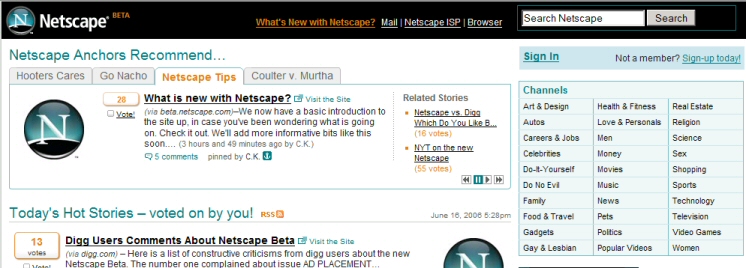Vertical 2.0 vs. Mass 2.0
The launch of AOL/Netscape’s multi-channel Digg clone/killer came in the same week as news of new verticals in the soon-to-be-launched version 3 of Digg. As with vertical search, both Digg and its imitators see an opportunity to carve up the community-driven news category.
The same is true of the related memetracker category, with Gabe Rivera now running four vertical versions of the original Memeorandum.
Ditto for social networking sites — for example, MySpace’s books, comedy, games, and movies verticals:

Like Netscape, these verticals within MySpace have no distinct branding. (How long do you think it took them to come up with MySpace Comedy?)

On Netscape, community topic interests are just a bunch of undifferentiated “channels” (a very 1.0 term, but then it is AOL).


On the flip side, you have companies launching verticals dedicated to serving one community, such as Marktd, the Digg-like PSFK spin-off that focuses on the marketing community, and Boompa, the social networking site for car enthusiasts.
Gabe’s memetracker sites seem to bridge the divide because they are separately branded with dedicated URLs — after he decided to spin off more verticals, Gabe clearly made an effort to more distinctly brand the gossip and baseball sites. Boompa is example of the purest form of vertical — they do cars and nothing but cars.
Which brings us to the key strategy question — **which is better, the branded niche approach or the uni-branded vertical approach?
**
Interesting, when TechCrunch wrote about Boompa, a commenter raised the issue of whether a general car site was niche enough:
Boompa is competing against thousands of generalist and niche oriented auto communities that already have established brands, huge user bases, and equal if not superior feature sets. Automotive enthusiasts choose communities about their specific vehicles – that is why communities like benzworld.org and m5board.com (which I frequent) are so much more popular than general communities like autoforums.com. If you are going to go after a larger landscape than just one manufacturer, than you should target a specific demographic and create a community around it like tunerfriends.com – boompa is just too generalist and too late to market.
To which Boompa founder Dave Snider responded:
You could be right, though traditionally umbrella sites do tend to handle more traffic then boards for no other reason then google (more content usually equates to more traffic). Cardomain, who I consider the site most similar to ours, is easily the largest non-classified car site on the net at present. Also, we are as far as I know the only car site that has a specific board per car model, so we do at least try to give people a narrow experience if they want it. Add that with a part specific database (who is using such and such part), user submitted guides (though we don’t have many at present) and there’s a potentially large amount of content to be built over time. Again… potentially, which isn’t saying much.
I believe you’re correct about relevance though. Are we going to be as relevant for VW fans as VWVortex? Definitely not. I think we’d be successful simply if people put their sigs linking to their car at boompa at those sites.
One could argue that the uni-branded vertical approach allows for cross-selling opportunities, but I’m betting that the niche approach will ultimately prevail. There is something very mass media 1.0 about the Netscape/MySpace approach of trying to be all things to all people.
But then again, that’s exactly what Yahoo did.
It remains to be seen how truly different Media 2.0 is from Media 1.0 — will it be level competition among thinly sliced niches or the same old consolidation and conglomeration?



